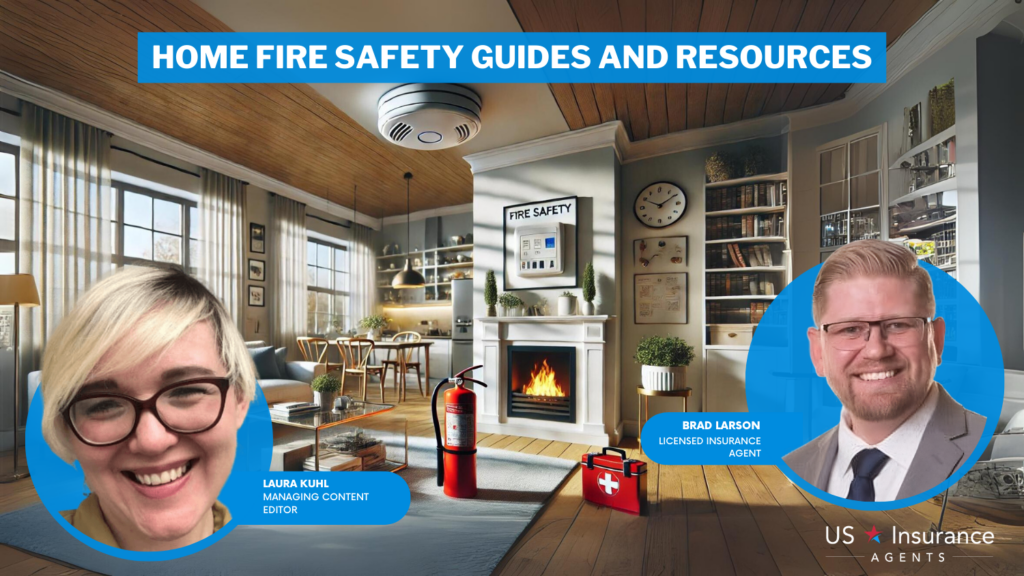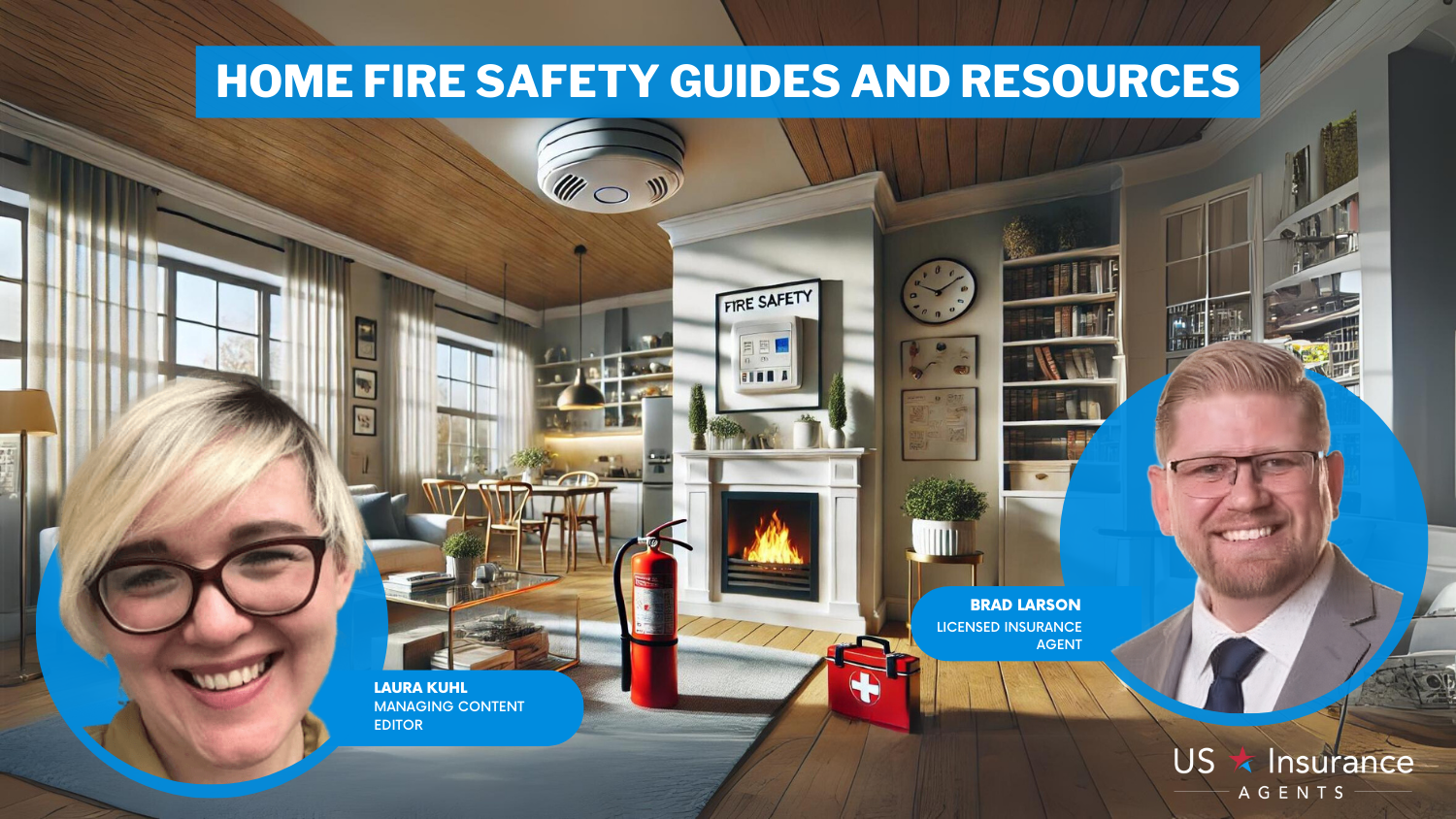Home Fire Safety Guides and Educational Resources
Unlock the Power of Home Fire Safety: Access Comprehensive Guides and Educational Resources for a Safer Living Environment. Discover essential tips, expert advice, and practical strategies to protect your home and loved ones from fire hazards. From prevention techniques to emergency preparedness, our resources provide invaluable insights and step-by-step guidance. Equip yourself with the knowledge and tools needed to create a secure living environment.`
Read more Secured with SHA-256 Encryption





Table of Contents
Table of Contents


Managing Editor
Laura Kuhl holds a Master’s Degree in Professional Writing from the University of North Carolina at Wilmington. Her career began in healthcare and wellness, creating lifestyle content for doctors, dentists, and other healthcare and holistic professionals. She curated news articles and insider interviews with investors and small business owners, leading to conversations with key players in the le...
Laura Kuhl


Sr. Director of Content
Sara Routhier, Senior Director of Content, has professional experience as an educator, SEO specialist, and content marketer. She has over 10 years of experience in the insurance industry. As a researcher, data nerd, writer, and editor, she strives to curate educational, enlightening articles that provide you with the must-know facts and best-kept secrets within the overwhelming world of insurance....
Sara Routhier


Licensed Insurance Agent
Brad Larson has been in the insurance industry for over 16 years. He specializes in helping clients navigate the claims process, with a particular emphasis on coverage analysis. He received his bachelor’s degree from the University of Utah in Political Science. He also holds an Associate in Claims (AIC) and Associate in General Insurance (AINS) designations, as well as a Utah Property and Casual...
Brad Larson
Updated January 2025
Welcome to our Home Fire Safety Guides and Educational Resources. In this comprehensive article, we provide essential information and resources to help you create a safer living environment.

Explore a wide range of topics, including fire prevention techniques, emergency preparedness, and home evacuation plans.
Our expert advice and practical tips will empower you to protect your home and loved ones from fire hazards. To ensure comprehensive protection for your home, enter your zip code below and compare rates from the best insurance providers. Don’t leave your home’s safety to chance. Take action today and secure the coverage you need for peace of mind.
General Fire Safety Tips
Not all fires are one hundred percent preventable. However, there are several steps you can take to reduce the amount of devastation a home fire could cause. Do your best to prevent a fire before it occurs and the damage may be minimized.
- Make sure there are smoke alarms on each level of your home and within earshot of every bedroom. About fifty percent of home fire deaths occur when most people are sleeping– between the hours of 11 pm and 7 am.
- Test all of your smoke detectors once a month and replace batteries regularly.
- Have a plan to get out of your home in less than two minutes– that’s the average amount of time it takes for a fire to get out of control.
- Once you are out of your home, stay out! Store keepsakes and mementos in a fire safe box so you aren’t tempted to re-enter the burning building.
- Never leave food unattended while cooking. According to the National Fire Protection Association, cooking equipment directly causes more fires than any other type of hazard.
- Avoid smoking in the home. Smoking materials result in more civilian home fire deaths than any other type of hazard, including kitchen fires.
- Refrain from using space heaters, if possible. Heating equipment is the second leading cause of both home fires and deaths resulting from home fire.
Free Home Insurance Comparison
Compare Quotes From Top Companies and Save
Secured with SHA-256 Encryption
Fire Safety For Small Children
In the United States alone, hundreds of children die in home fires each year, and the problem is even worse globally. It is essential that young children be taught critical fire safety tips before a disaster occurs. While fires are scary for anyone, they can be especially terrifying to children who don’t know how to react. Before a fire happens, teach your children what to do and where to go if they hear the smoke alarm. A well-prepared child will be less likely to hide out of fear and will ultimately be safer.
- Have a fire drill at home and coach your child through your family’s escape plan. Older children are often taught how to react to a fire drill at school, but pre-school age children and toddlers may not know what to do. So, be sure to address any questions or concerns your child has.
- Teach your child not to open a door if the doorknob is hot. If the knob is hot, the room isn’t safe.
- In addition to ensuring matches and lighters are stored up high, away from children, teach your kids that they should never play with these items if they are found left out.
- Talk with your child about basic safety around the home, including electrical outlet safety and other potential fire hazards.
For more resources on fire safety and education for small children, please refer to the following:
- Fire Safety Facts and Tips (SafeKids.org)
- Fire Safety for Kids, Made Fun (FireSafeKids.org)
- Play Safe! Be Safe! Preschooler Fire Safety (NAEYC.org)
Fire Education for Older Kids and Teens
Parents can rest comfortably knowing that once their children are teenagers or pre-teens, they are more likely to remain calm in the event of a fire and have a better chance of making it out safely. However, kids in this age group are actually more likely to cause house fires. The majority of house fires started by children are accidents, but there are a few that are started intentionally. Fortunately, discussing fire safety and prevention with your children on a regular basis can prevent blazes.
- Make a family escape plan and discuss it with your kids. Be sure everyone is on the same page in regards to getting out of the home and where to go once they’re out.
- Since many pre-teens and teenagers use the microwave and maybe even the stove, discuss kitchen safety. Younger pre-teens and inexperienced teens should be instructed to never heat anything in the kitchen without an adult’s supervision.
- Instruct your children on what to do if they cannot safely escape their room or another part of the home. They should know how to cover vents and doorways to prevent smoke from entering the room and have access to a flashlight to signal for help.
- Talk to teenagers about burning candles in their bedroom and make sure they never leave one burning while asleep.
- Cell phones may overheat while charging and cause a fire if they are near something flammable, such as bedding. Warn your teen to never sleep with their phone in the bed or under their pillow, especially while the phone is charging.
Below are additional sites to learn more about fire safety for older children, teens and young adults:
- Fire Safety: What Every Child Should Know (Youtube Video)
- Dealing with Burns (KidsHealth.org)
- Fire Safety Resource Materials for Teenagers (Fire Safety Council)
- Fire Safety and Fire Prevention (National Institutes of Health)
Pet Fire Safety Resources
- Fire Safety for Pet Owners (Electrical Safety Foundation International)
- Pet Fire Safety (Oklahoma State University)
- Prevention Tips To Keep Pets From Starting Home Fires (American Kennel Club)
- Pet Safety Checklist (YC.edu)
- Fire Safety for Homes with Dogs (Labrador Rescuers)
Free Home Insurance Comparison
Compare Quotes From Top Companies and Save
Secured with SHA-256 Encryption
Fire Safety for Seniors
According to the Administration for Community Living, over twelve millions seniors live alone. While your loved ones may be independent enough to stay in their own homes, they may need your help to be safe in the event of a fire. If you aren’t able to check on your elderly family members personally, find a trusted friend or neighbor who would be willing to help.
- Unlike statistics pertaining to the general population, amongst seniors, smoking is the leading cause of home fire deaths. Talk to your loved ones about smoking in the home and discuss making the change to an e-cigarette, if possible.
- Never allow your loved one or visitors to smoke near an oxygen tank, even if it isn’t in use.
- Cigarettes should be doused with water before they are discarded to reduce any risk of fire.
- Lit cigarettes should never be left on furniture.
- Always make sure that any cigarette butts are fully extinguished before going to sleep, and never smoke when drowsy.
- For seniors who must rely on the use of a space heater, use all necessary precautions to prevent fire. They should be at least three feet away from easily combustible material, especially bedding and curtains.
- Encourage your loved ones to turn off their space heaters before they go to sleep or leave the home.
- Make sure elderly family members can exit their home from any location in under two minutes. For seniors with mobility problems, this may mean creating access to multiple exits.
Here are additional resources for seniors:
- Fire Safety for Seniors Booklet (PDF) (NYC.gov)
- Home Fire Safety for Older Adults Safety Awareness Program Toolkit (Electrical Safety Foundation International)
- Fire Safety Tips for Older Adults (Seattle Fire Department)
Fire Safety Resources for the Disabled
Fire can be dangerous for anyone but can pose unique challenges for people with disabilities. People with disabilities may have more difficulty escaping a fire or calling for help. Below is a list of resources that can provide advice and information on fire safety for people with disabilities.
- Fire Safety Solutions for People with Disabilities (PDF) (OK.gov)
- Evacuation for persons with disabilities (Vanderbilt University)
- Fire Safety for the Disabled (Fairfax County, VA)
- Fire Safety Skills (Mountain State Centers for Independent Living)
- Safety Issues for the Disabled (PDF) (Lousiana Tech University)
- Guide to Teaching Fire Safety to Students with Disabilities (PDF) (Michael H. Minger Foundation)
- Fire Safety for People with Disabilities (Monroe Township Fire District Two)
- Fire Safety for Wheelchair Users at Work and at Home (PDF) (United Spinal Association)
How to Create a Safety Plan for Your Family
Not all families will have identical safety plans. While the internet is a great source of tips and sample plans, you will probably need to tweak them to fit your family’s needs. Keep in mind that it may be necessary to change your plan if you move or your family grows.
- Be sure everyone in your household knows what exits are available, including windows.
- If possible, discuss two possible exits from each room in the home.
- Hold a practice fire drill and make sure that the entire family can safely evacuate in less than two minutes.
- If any family members have mobility issues, another family member should be assigned to help get that individual out of the house safely.
- Agree on one meeting place outside the home. It should be a safe distance from the house.
- Regularly check to make sure that any possible exits are not blocked by furniture or clutter.
Here are some additional resources on fire safety plans:
- Escape Planning (NFPA)
- Home fire escape planning outreach materials (FEMA)
- Fire Safety Plan Template (Regional Municipality of Wood Buffalo)
- Fire Escape Planning Fact Sheet (Red Cross)
- A Smart Fire Safety Plan (Parents.com)
Free Home Insurance Comparison
Compare Quotes From Top Companies and Save
Secured with SHA-256 Encryption
Additional Resources for Educators
If you would like to learn more about fire safety, prevention, and education, here are some links that may be useful:
- Fire Safety Educators: http://firesafetyeducators.org
- Alarming Truth: http://alarmingtruth.org/firesafety-education-resources/
- National Fire Protection Association: http://www.nfpa.org
- Sparky the Fire Dog: http://www.sparky.org
- U.S. Fire Administration Guide for Older Adults: https://www.usfa.fema.gov/prevention/outreach/older_adults.html
- Stop Fire Setting: http://www.stopfiresetting.com/
Case Studies: Home Fire Safety Guides and Educational Resources
Case Study 1: CityX’s Home Fire Safety Campaign
CityX experienced a rise in residential fires, prompting city authorities to launch a home fire safety campaign. The campaign included an interactive online guide with fire prevention tips, escape planning, and fire extinguisher usage. Workshops and printed materials were distributed in partnership with local fire departments.
As a result, residential fire incidents decreased by 30% in the first year. The online guide’s accessibility and community engagement empowered CityX residents to proactively address home fire safety.
Case Study 2: The SafeHome App: Empowering Families in Suburbia
To enhance fire safety awareness in Suburbia, a nonprofit organization developed the SafeHome app—an innovative mobile application for residents. The app provided comprehensive resources, including fire escape plans, tailored fire prevention tips, and a checklist for smoke detectors and fire extinguishers. It also sent push notifications for smoke alarm maintenance.
Within six months, over 5,000 households downloaded the app, demonstrating high community engagement. The SafeHome app increased fire safety awareness and encouraged residents to take responsibility for their homes and families’ safety.
Case Study 3: The School Fire Safety Program in Rural Village Y
o address the lack of fire safety resources in Rural Village Y, the local school partnered with the fire department to implement a program. This program included workshops, presentations, and demonstrations on fire prevention, evacuation drills, and proper equipment use. Each household received a fire safety kit. As a result, fire accidents decreased, and the community became more knowledgeable, with students educating others.
The program served as a model for other rural communities. Company Z, an insurance provider, launched a nationwide fire safety awareness campaign. Collaborating with fire departments, educational institutions, and community organizations, they utilized social media, webinars, and workshops. Company Z also created user-friendly fire safety guides distributed online and through various channels.

Frequently Asked Questions
Where can I find home fire safety guides and educational resources?
Home fire safety guides and educational resources can be found online or at your local fire department or insurance company. The National Fire Protection Association (NFPA) and the U.S. Fire Administration (USFA) also offer a variety of free resources, including tip sheets, checklists, and videos.
What kind of information is included in a home fire safety guide?
A home fire safety guide typically includes information on fire prevention, such as how to avoid common fire hazards in the home, as well as tips on how to create a fire escape plan and how to use a fire extinguisher. It may also include information on smoke detectors and other fire safety equipment.
What educational resources are available for kids and teens?
There are a variety of educational resources available for kids and teens, including online games, videos, and interactive activities that teach fire safety in a fun and engaging way. The NFPA also offers a free program called “Learn Not to Burn®” that is specifically designed for children in grades K-5.
Are there resources available for people with disabilities or impairments?
Yes, there are resources available for people with disabilities or impairments, including information on how to create a fire escape plan that takes into account mobility, vision, or hearing impairments. The NFPA and USFA also offer resources that are specifically tailored to the needs of people with disabilities or impairments.
How can I use home fire safety guides and educational resources to make my home safer?
You can use home fire safety guides and educational resources to identify potential fire hazards in your home, create a fire escape plan, and learn how to use a fire extinguisher. You can also use these resources to educate your family on fire safety and to practice fire drills regularly to make sure everyone knows what to do in case of a fire.
What should I do if I have questions about home fire safety?
If you have questions about home fire safety, you can contact your local fire department or insurance company for advice. You can also visit the NFPA or USFA websites for more information or to find resources in your area.
Get a FREE Quote in Minutes
Insurance rates change constantly — we help you stay ahead by making it easy to compare top options and save.

